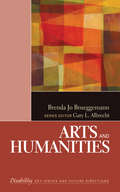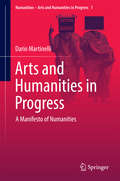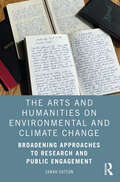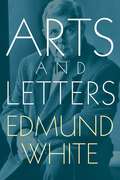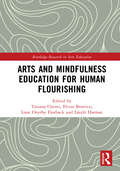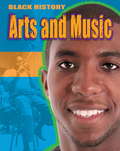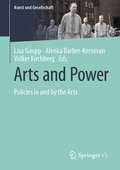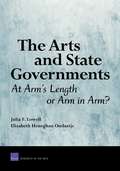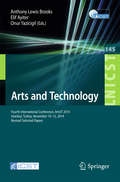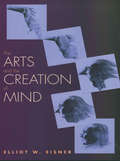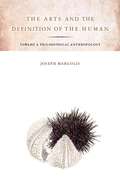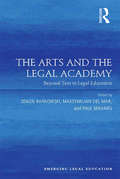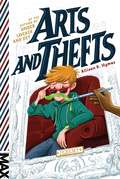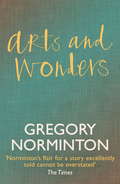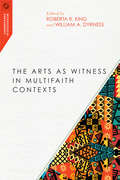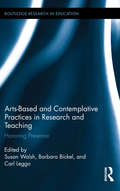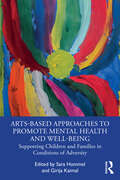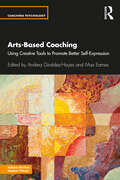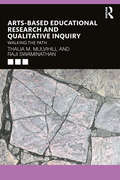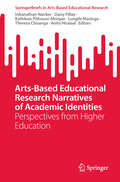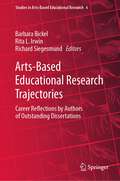- Table View
- List View
Arts and Humanities (The SAGE Reference Series on Disability: Key Issues and Future Directions)
by Brenda Jo BrueggemannThis volume in The SAGE Reference Series on Disability explores the arts and humanities within the lives of people with disabilities. It is one of eight volumes in the cross-disciplinary and issues-based series, which incorporates links from varied fields making up Disability Studies as volumes examine topics central to the lives of individuals with disabilities and their families. With a balance of history, theory, research, and application, specialists set out the findings and implications of research and practice for others whose current or future work involves the care and/or study of those with disabilities, as well as for the disabled themselves. The presentational style (concise and engaging) emphasizes accessibility. Taken individually, each volume sets out the fundamentals of the topic it addresses, accompanied by compiled data and statistics, recommended further readings, a guide to organizations and associations, and other annotated resources, thus providing the ideal introductory platform and gateway for further study. Taken together, the series represents both a survey of major disability issues and a guide to new directions and trends and contemporary resources in the field as a whole.
Arts and Humanities in Progress: A Manifesto of Numanities (Numanities - Arts and Humanities in Progress #1)
by Dario MartinelliThe book aims to introduce a research concept called "Numanities", as one possible attempt to overcome the current scientific, social and institutional crisis of the humanities. Such crisis involves their impact on, and role within, society; their popularity among students and scholars; and their identity as producers and promoters of knowledge. The modern western world and its economic policies have been identified as the strongest cause of such a crisis. Creating the conditions for, but in fact encouraging it. However, a self-critical assessment of the situation is called for. Our primary fault as humanists was that of stubbornly thinking that the world's changes could never really affect us, as - we felt - our identity was sacred. In the light of these approaches, the main strengths of humanities have been identified in the ability to: promote critical thinking and analytical reasoning; provide knowledge and understanding of democracy and social justice; develop leadership, cultural and ethical values. The main problems of humanities are the lack economic relevance; the socio-institutional perception of them as "impractical" and unemployable; the fact that they do not match with technological development. Finally, the resulting crisis consists mainly in the absence (or radical reduction) of funding from institutions; a decrease in student numbers a decrease in interest; a loss of centrality in society. A Numanities (New Humanities) project should consider all these aspects, with self-critical assessment on the first line. The goal is to unify the various fields, approaches and also potentials of the humanities in the context, dynamics and problems of current societies, and in an attempt to overcome the above-described crisis. Numanities are introduced not as a theoretical paradigm, but in terms of an "umbrella-concept" that has no specific scientific content in it: that particularly means that the many existing new fields and research trends that are addressing the same problems (post-humanism, transhumanism, transformational humanities, etc. ) are not competitors of Numanities, but rather possible ways to them. Therefore, more than a theoretical program, Numanities intend to pursue a mission, and that is summarized in a seven-point manifesto. In the light of these premises and reflections, the book then proceeds to identify the areas of inquiry that Numanities, in their functions and comprehensive approach, seek to cover. The following list should also be understood as a statement of purposes for this entire book series. These, in other words, will be the topics/areas we intend to represent. Once elaborated on the foundations of Numanities, the book features a second part that presents two case studies based on two relatively recent (and now updated) investigations that the author has performed in the fields of musical and animal studies respectively. The two cases (and relative areas of inquiry) were selected because they were considered particularly relevant within the discussion of Numanities, and in two different ways. In the first case-study the author discussed the most typical result (or perhaps cause?) of the technophobic attitude that was addressed in the first part of the book: the issue of "authenticity", as applied, in the author's particular study, to popular music. In the second case-study, he analyzes two different forms of comparative analysis between human and non-human cognition: like in the former case, this study, too, is aimed at a critical commentary on (what the author considers) redundant biases in current humanistic research - anthropocentrism and speciesism.
The Arts and Humanities on Environmental and Climate Change: Broadening Approaches to Research and Public Engagement
by Sarah SuttonThe Arts and Humanities on Environmental and Climate Change examines how cultural institutions and their collections can support a goal shared with the scientific community: creating a climate-literate public that engages with environmental issues and climate change in an informed way. When researchers, curators, and educators use the arts and humanities to frame discussions about environmental and climate change, they can engage a far wider public in learning, conversation, and action than science can alone. Demonstrating that archival and object-based resources can act as vital evidence for change, Sutton shows how the historical record, paired with contemporary reality, can create more personal connections to what many consider a remote experience: the changing climate. Providing valuable examples of museum collections used in discussions of environmental and climate change, the book shares how historic images and landscape paintings demonstrate change over time; and how documentary evidence in the form of archaeological reports, ships logs, Henry David Thoreau’s journals, and local reports of pond hockey conditions are being used to render climate data more accessible. Images, personal records, and professional documents have critical roles as boundary objects and proxy data. These climate resources, Sutton argues, are valuable because they make climate change personal and attract a public less interested in a scientific approach. This approach is underused by museums and their research allies for public engagement and for building institutional relevancy. The Arts and Humanities on Environmental and Climate Change will be most interesting to readers looking for ways to broaden engagement with environmental and climate issues. The ideas shared here should also act as inspiration for a broad spectrum of practitioners, particularly those writing, designing, and curating public engagement materials in museums, for wider research, and for the media.
Arts and Letters
by Edmund WhiteA dazzling collection of profiles and interviews by the preeminent American cultural essayist of our time. In these 39 lively essays and profiles, best-selling novelist and biographer Edmund White draws on his wide reading and his sly good humor to illuminate some of the most influential writers, artists, and cultural icons of the past century: among them, Marcel Proust, Catherine Deneuve, George Eliot, Andy Warhol, André Gide, David Geffen, and Robert Mapplethorpe. Whether he's praising Nabokov's sensuality, or critiquing Elton John's walk ("as though he's a wind-up doll that's been overwound and sent heading for the top of the stairs"), or describing serendipitous moments in his seven-year-long research into the life of Genet, White is unfailingly observant, erudite, and entertaining.
Arts and Mindfulness Education for Human Flourishing (Routledge Research in Arts Education)
by László HarmatThis edited volume explores the role of arts and meditation within educational settings, and looks in particular at the preventive and developmental function of the arts in educational contexts through different theoretical perspectives. Encompassing research from an array of disciplines including theatre, psychology, neuroscience, music, psychiatry, and mindfulness, the book draws insights relevant to a broad spectrum of interdisciplinary fields. Chapters are divided into thematic sections, each outlining praxes and emphasising how educating within and through the arts can provide tools for critical thinking, creativity and a sense of agency, consequently fulfilling the need of well-being and contributing towards human flourishing. Ultimately, the book focuses on the role the arts have played in our understanding of physical and mental health, and demonstrates the new-found significance of the discipline in the wake of the COVID-19 pandemic. With its interdisciplinary and timely nature, this book will be essential reading for scholars, academics, and post-graduate researchers in the field of arts education, creative therapies, neuroscience, psychology, and mindfulness.
Arts and Minds: How the Royal Society of Arts Changed a Nation
by Anton HowesA major new history of the extraordinary society that has touched all aspects of British lifeFrom its beginnings in a coffee house in the mid-eighteenth century, the Royal Society for the Encouragement of Arts, Manufactures and Commerce has tried to improve British life in every way imaginable. It has sought to influence how Britons work, how they are educated, the music they listen to, the food they eat, the items in their homes, and even how they remember their own history. Arts and Minds is the remarkable story of an institution unlike any other—a society for the improvement of everything and anything.Drawing on exclusive access to a wealth of rare papers and artefacts from the Society's own archives, Anton Howes shows how this vibrant and singularly ambitious organisation has evolved and adapted, constantly having to reinvent itself to keep in step with changing times. The Society has served as a platform for Victorian utilitarian reformers, purchased and restored an entire village, encouraged the planting of more than sixty million trees, and sought technological alternatives to child labour. But this is more than just a story about unusual public initiatives. It is an engaging and authoritative history of almost three centuries of social reform and competing visions of a better world—the Society's members have been drawn from across the political spectrum, including Adam Smith, Edmund Burke, and Karl Marx.Informative and entertaining, Arts and Minds reveals how a society of public-spirited individuals tried to make their country a better place, and draws vital lessons from their triumphs and failures for all would-be reformers today.
Arts and Music (Black History #2)
by Dan Lyndon-CohenWhether you enjoy listening to music, reading books and poetry, watching films or visiting art museums, the contributions made by artists and performers of African origin are all around you. Rising out of the shackles of slavery in centuries past, to increased recognition in this new century, it is clear that black people have made an enormous contribution to culture around the world. This book looks at the influences and key movements in the development of black artists and their work across the generations.The Black History series brings together a wide range of events and experiences from the past to promote knowledge and understanding of black culture today. This book looks at the influences and key movements in the development of black artists and their work across the generations.
Arts and Power: Policies in and by the Arts (Kunst und Gesellschaft)
by Lisa Gaupp Alenka Barber-Kersovan Volker KirchbergThe focus on concepts of power and domination in societal structures has characterized sociology since its beginnings. Max Weber’s definition of power as “imposing one’s will on others” is still relevant to explaining processes in the arts, whether their production, imagination, communication, distribution, critique or consumption. Domination in the arts is exercised by internal and external rulers through institutionalized social structures and through beliefs about their legitimacy, achieved by defining and shaping art tastes.The complexity of how the arts relate to power arises from the complexity of the policies of artistic production, distribution and consumption—policies which serve to facilitate or hinder an aesthetic object from reaching its intended public. Curators, critics and collectors employ a variety of forms of cultural and artistic communication to mirror and shape the dominant social, economic and political conditions.Arts and Power: Policies in and by the Arts brings together diverse voices who position the societal functions of art in fields of domination and power, of structure and agency—whether they are used to impose hegemonic, totalitarian or unjust goals or to pursue social purposes fostering equal rights and grassroots democracy. The contributions in this volume are exploratory steps towards what we believe can be a more systematic, empirically and theoretically founded sociological debate on the arts and power. And they are an invitation to take further steps.
Arts and Science at Toronto
by Craig BrownThe University of Toronto's Faculty of Arts and Science is older than the university itself. Chartered in 1827 as King's College, it officially opened in 1843 with four professors and twenty-seven students. In this lively and engaging book, Robert Craig Brown vividly recounts the 150-year history of the faculty's staff, students, and achievements.Brown takes readers on a sweeping journey though the development and growth of the faculty through wartime and peace, depression and prosperity. He covers teaching and research in the vast array of subjects offered, administrative and financial concerns, and the Faculty's significant contributions to higher education in Canada. Throughout, Brown traces how the faculty evolved past its early defining traits of elitism and exclusivity to its current form - a remarkably diverse body with students of all ages, backgrounds, and academic interests.
The Arts and State Governments
by Julia F. Lowell Elizabeth Heneghan OndaatjeState government spending on the arts is minimal-and may be losing ground relative to other state expenditures. The authors examine efforts made by state arts agencies, or SAAs, to address a changing political and fiscal environment and present their findings on the risks and rewards of bringing the arts and political worlds closer together.
Arts and Technology: Fourth International Conference, ArtsIT 2014, Istanbul, Turkey, November 10-12, 2014, Revised Selected Papers (Lecture Notes of the Institute for Computer Sciences, Social Informatics and Telecommunications Engineering #145)
by Anthony Lewis Brooks Elif Ayiter Onur YazicigilThis book constitutes the thoroughly refereed proceedings of the Fourth International Conference on Arts and Technology, ArtsIT 2014, held in Istanbul, Turkey, in November 2014. The 17 revised full papers presented were carefully selected and reviewed from numerous submissions. ArtsIT has become a leading scientific forum for the dissemination of cutting-edge research results in the area of arts, design and technology. The papers focus on IT technologies, artists, designers and industrial members and offer content creators tools that expand the means of expression of the traditional design field.
The Arts and the Creation of Mind
by Elliot W. EisnerAlthough the arts are often thought to be closer to the rim of education than to its core, they are, surprisingly, critically important means for developing complex and subtle aspects of the mind, argues Elliot Eisner in this engrossing book. In it he describes how various forms of thinking are evoked, developed, and refined through the arts. These forms of thinking, Eisner argues, are more helpful in dealing with the ambiguities and uncertainties of daily life than are the formally structured curricula that are employed today in schools. Offering a rich array of examples, Eisner describes different approaches to the teaching of the arts and the virtues each possesses when well taught. He discusses especially nettlesome issues pertaining to the evaluation of performance in the arts. Perhaps most important, Eisner provides a fresh and admittedly iconoclastic perspective on what the arts can contribute to education, namely a new vision of both its aims and its means. This new perspective, Eisner argues, is especially important today, a time at which mechanistic forms of technical rationality often dominate our thinking about the conduct and assessment of education.
The Arts and the Definition of the Human
by Joseph MargolisThe Arts and the Definition of the Humanintroduces a novel theory that our selves-our thoughts, perceptions, creativity, and other qualities that make us human-are determined by our place in history, and more particularly by our culture and language. Margolis rejects the idea that any concepts or truths remain fixed and objective through the flow of history and reveals that this theory of the human being (or "philosophical anthropology") as culturally determined and changing is necessary to make sense of art. He shows that a painting, sculpture, or poem cannot have a single correct interpretation because our creation and perception of art will always be mitigated by our historical and cultural contexts. Calling upon philosophers ranging from Parmenides and Plato to Kant, Hegel, and Wittgenstein, art historians from Damisch to Elkins, artists from Van Eyck to Michelangelo to Wordsworth to Duchamp, Margolis creates a philosophy of art interwoven with his philosophical anthropology which pointedly challenges prevailing views of the fine arts and the nature of personhood.
The Arts and the Legal Academy: Beyond Text in Legal Education (Emerging Legal Education)
by Maksymilian Del Mar Paul Maharg Zenon BańkowskiIn Western culture, law is dominated by textual representation. Lawyers, academics and law students live and work in a textual world where the written word is law and law is interpreted largely within written and printed discourse. Is it possible, however, to understand and learn law differently? Could modes of knowing, feeling, memory and expectation commonly present in the Arts enable a deeper understanding of law's discourse and practice? If so, how might that work for students, lawyers and academics in the classroom, and in continuing professional development? Bringing together scholars, legal practitioners internationally from the fields of legal education, legal theory, theatre, architecture, visual and movement arts, this book is evidence of how the Arts can powerfully revitalize the theory and practice of legal education. Through discussion of theory and practice in the humanities and Arts, linked to practical examples of radical interventions, the chapters reveal how the Arts can transform educational practice and our view of its place in legal practice. Available in enhanced electronic format, the book complements The Moral Imagination and the Legal Life, also published by Ashgate.
The Arts and the Teaching of History: Historical F(r)ictions
by Penney Clark Alan SearsThis book closely examines the pedagogical possibilities of integrating the arts into history curriculum at the secondary and post-secondary levels. Students encounter expressions of history every day in the form of fiction, paintings, and commemorative art, as well as other art forms. Research demonstrates it is often these more informal encounters with history that define students’ knowledge and understandings rather than the official accounts present in school curricula. This volume will provide educators with tools to bring together these parallel tracks of history education to help enrich students’ understandings and as a mechanism for students to present their own emerging historical perspectives.
Arts and Thefts (MAX)
by Allison K. HymasMiddle school retrieval specialist Jeremy Wilderson must team up with preteen private detective Becca Mills once again to solve his most mind-boggling case yet in this action-packed MAX novel.Ahh, summer vacation! Jeremy Wilderson, Scottsville Middle School’s first (and only) retrieval specialist, is enjoying a slower-than-usual season of retrieving (NOT stealing) lost objects in order to help the under thirteen population of Scottsville. But crime doesn’t take a vacation! And when sabotage strikes Scottsville’s event of the year—the Summer Art Show—threatening to ruin the burgeoning painting career of Jeremy’s best friend, Case, it’s up to Jeremy to figure out what’s going on. Of course, his archrival Becca Mills, who just happens to think Jeremy, Case, and their friend Hack are involved in the crime, is also looking into it. Jeremy has only a few precious hours to stop the sabotage before more contest entries—and kids’ dreams—are slashed and burned. But Jeremy’s specialty is retrieval…not detective work! The only solution is to team up with Becca to solve the case, something Jeremy’s not exactly thrilled to do. Not to mention, he has to keep his alliance with Becca a secret from Case and Hack, who will disown him if they see him working with the enemy. Somewhere between being stuck inside an air vent and slathered in red paint, Jeremy has to wonder: is he in over his head?
Arts and Wonders
by Gregory NormintonARTS AND WONDERS spans a glorious canvas, peopled by werewolves, thieves, emperors, travelling players and a forger dwarf who takes a lifetime to learn the danger of illusions.Tomasso Grilli, a dwarf gifted with an extraordinary capacity for artistic forgery (and flexible morals) recounts the story of his life, from his base beginnings in Florence, through his apprenticeship to the painter Arcimboldo, to his life of crime in Prague and subsequent banishment, to the gilded fame he finds as 'librarian' and collector to the court of an impoverished, ignorant ruler in the German Dukedom of Felsungrunde. Grilli's ambition and dubious skills take him to the pinnacle of success only for it to collapse beneath him like the illusion it always was. Betrayed and reviled he leaves Felsungrunde, is forced to join a group of travelling players, and finally learns the value of friendship. loyalty and honesty. The extraordinary cast of characters (some based on real historical figures) includes werewolves, an occult alchemist, a bear, a dodo, a lion and a maker of mechanical dolls.
Arts and Wonders
by Gregory NormintonARTS AND WONDERS spans a glorious canvas, peopled by werewolves, thieves, emperors, travelling players and a forger dwarf who takes a lifetime to learn the danger of illusions.Tomasso Grilli, a dwarf gifted with an extraordinary capacity for artistic forgery (and flexible morals) recounts the story of his life, from his base beginnings in Florence, through his apprenticeship to the painter Arcimboldo, to his life of crime in Prague and subsequent banishment, to the gilded fame he finds as 'librarian' and collector to the court of an impoverished, ignorant ruler in the German Dukedom of Felsungrunde. Grilli's ambition and dubious skills take him to the pinnacle of success only for it to collapse beneath him like the illusion it always was. Betrayed and reviled he leaves Felsungrunde, is forced to join a group of travelling players, and finally learns the value of friendship. loyalty and honesty. The extraordinary cast of characters (some based on real historical figures) includes werewolves, an occult alchemist, a bear, a dodo, a lion and a maker of mechanical dolls.
The Arts as Witness in Multifaith Contexts (Missiological Engagements)
by William A. Dyrness Roberta R. KingIn search of holistic Christian witness, missionaries have increasingly sought to take into account all the dimensions of people's cultural and religious lives—including their songs, dances, dramatic performances, storytelling, and visual arts.
Arts-based and Contemplative Practices in Research and Teaching: Honoring Presence (Routledge Research in Education)
by Susan Walsh Barbara Bickel Carl LeggoThis volume presents a scholarly investigation of the ways educators engage in artistic and contemplative practices – and why this matters in education. Arts-based learning and inquiry can function as a powerful catalyst for change by allowing spiritual practices to be present within educational settings, but too often the relationship between art, education and spirituality is ignored. Exploring artistic disciplines such as dance, drama, visual art, music, and writing, and forms such as writing-witnessing, freestyle rap, queer performative autoethnograph, and poetic imagination, this book develops a transformational educational paradigm. Its unique integration of spirituality in and through the arts addresses the contemplative needs of learners and educators in diverse educational and community settings.
Arts-Based Approaches to Promote Mental Health and Well-Being: Supporting Children and Families in Conditions of Adversity
by Sara Hommel Girija KaimalThis book provides insights on how creative and expressive approaches can promote psychosocial well-being among children, youth, and their caregivers living in conditions of adversity around the world.Arts-based psychosocial approaches give children a means to tap into their strengths as well as adaptively communicate and process experiences in ways that promote their own and overall family well-being. Offering an overview of the impact of adverse childhood experiences on lifelong health and functioning and how arts-based approaches can be protective, this book discusses relevant theory and research, as well as case studies and findings from mixed methods program evaluations. Examples from the Healing and Education Through the Arts (HEART) initiative from Save the Children are discussed in depth, and demonstrate the benefits of creative self-expression among children and families in the most challenging environments around the world.Creative arts therapists, public health professionals, education specialists, policymakers, and humanitarian groups seeking to provide cost-effective support to communities in need will find, in this book, insights on the impact of large-scale arts-based interventions in a range of public health and education settings.
Arts-Based Coaching: Using Creative Tools to Promote Better Self-Expression (Coaching Psychology)
by Andrea Giraldez-Hayes Max EamesThis book, written in an accessible way by leading experts in the field, offers a comprehensive exploration of arts integration in coaching through the lenses of positive and health psychology.Drawing together international experts and interdisciplinary perspectives, including health and neuroscience, the book explores the intersection of positive psychology and the arts, offering insights and strategies for using art to promote personal growth. The chapters in this book weave theory into practice, condense research and theoretical concepts into straightforward frameworks, and offer easily understandable ideas and examples. It provides a theoretical rationale for various art forms, including poetry, music, visual arts, dance, cinema, and photography. Each chapter includes case studies to present practical ways in which arts can enhance coaching conversations.Arts-Based Coaching is a practical guide that will interest coaching psychologists, coaches, dual practitioners offering therapeutic coaching, leaders, educators, and other professionals using coaching in their professional practice, as well as course leaders and students in coaching and coaching psychology.
Arts-Based Educational Research and Qualitative Inquiry: Walking the Path
by Thalia M. Mulvihill Raji SwaminathanArts-Based Educational Research and Qualitative Inquiry introduces novice qualitative researchers, within education and related fields, to arts-based educational research (ABER). Abundant prompts and exercises are provided to help readers apply the concepts and experiment with various applications of the ideas presented. The authors walk the path with novice researchers offering a variety of approaches to the practice of arts-based methods, while providing a guided overview of ABER, and include pedagogical features in each chapter. Exercises are designed to assist educational researchers who wish to expand their repertoire of methodologies. The authors also weave into the discussion the possibilities and limitations of many types of arts-based methods while introducing readers to the growing methodological literature. By offering a tapestry of ways to engage the novice researcher, the book illustrates that it is not always possible to separate cognitive findings from aesthetic knowing. This book will help qualitative researchers to expand their methodologies to include arts-based approaches to their projects and by doing so reshape their identities as qualitative researchers. It also offers some evaluative criteria and tool kits for experimenting with various arts and educational research.
Arts-Based Educational Research Narratives of Academic Identities: Perspectives from Higher Education (SpringerBriefs in Arts-Based Educational Research)
by Inbanathan Naicker Daisy Pillay Kathleen Pithouse-Morgan Lungile Masinga Theresa Chisanga Anita HiralaalThis book delves into the complexities of being and becoming an academic in higher education. Inspired by the arts, the book introduces new voices and insights to scholarly discussions about what constitutes data and analysis in higher education research. It demonstrates ABER’s ability to shape and critique academic identity narratives in response to pressing problems and dilemmas in higher education. The book includes exemplars from studies conducted primarily in South African contexts and led by South African researchers. It explores diverse modes, including collage, digital artwork, letter writing, metaphor, creative nonfiction, and theatre-making. Contributions from expert scholars in Canada and the USA supplement this research and show how it has been enriched by critical transcontinental conversations. The authors offer new perspectives on the entwined and complex relationship between the ABER, narratives, and identities.
Arts-Based Educational Research Trajectories: Career Reflections by Authors of Outstanding Dissertations (Studies in Arts-Based Educational Research #6)
by Barbara Bickel Rita L. Irwin Richard SiegesmundThis book offers reflections from Arts-Based Educational Research (ABER) scholars who, since 2005, were awarded the American Educational Research Association ABER Special Interest Group's Outstanding Dissertation Award. The book includes essays from ten awardees who, across diverse artistic disciplines, share how their ABER careers evolve and succeed—inspiring insights into the possibilities of ABER. It also examines the essential role of mentorship in the academy that supports and expands ABER scholarship. Drawing from dissertation exemplars in the field, this book allows readers to look at how ABER scholars learn with the world while creatively researching and teaching in innovative ways
